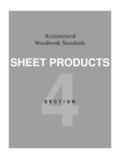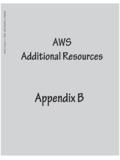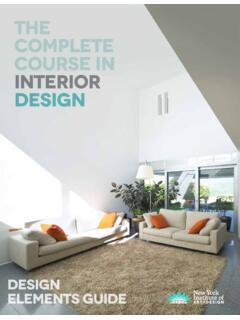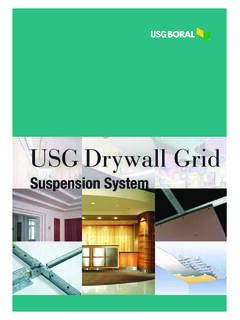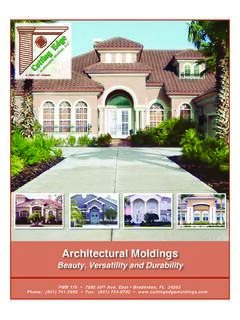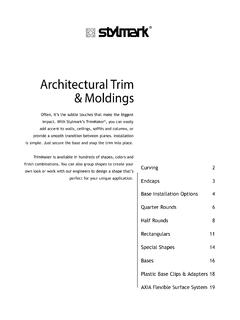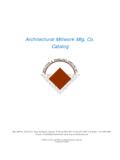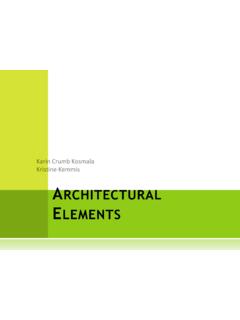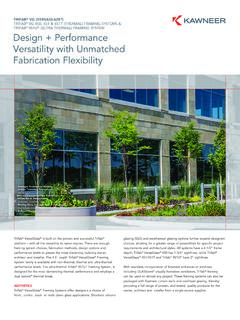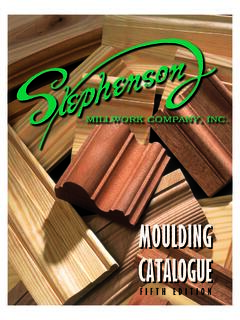Transcription of Architectural Woodwork Standards doors 9
1 ArchitecturalWoodwork Standardsdoors9s e c t i o nsection 9 DoorsArchitectural Woodwork Standards 2014 AWI | AWMAC | WI 2nd Edition, October 1, 20142349 Architectural Woodwork Standards234table of contentsIntroductory InForMAtIonGuide Specifications ..238 Introduction ..239 Exterior doors ..239 Code and Rule Requirements ..239 Face Material Selection ..239 Veneers for Transparent Finish ..239 Materials for Opaque Finishes ..239 High Pressure Decorative Laminates (HPDL) ..239 Door Symbols and Abbreviations ..240 Basic Core Types ..240 Speciality Cores ..241 Fire Rated ..241 Sound Resistant ..241X-ray ..241 Bullet Resistant ..241 Electrostatic Shielded ..241 Core to Edge Assembly ..241 Fire Ratings ..241 Code and Rule Requirements ..241 Special Function doors ..241 Veneer Faces ..241 Veneer Face Grade Summary ..241 doors in Pairs or Sets ..242 Pair Match ..242 Set Match ..242 doors with Transoms ..242 Continuous Match.
2 242 End Match ..242No Match ..242 Door Edge Construction and Types ..242 Construction Definitions ..243 Wood Face ..2435 Ply ..2437 Ply ..243 HPDL Face ..2433 Ply ..2435 Ply ..243 Door Construction Cutaway Examples ..243 Wood Veneer Face, PC-7/PC-7 ..243 HPDL Face, PC-HPDL-3 or PC-HPDL-5 ..243 Wood Veneer Face, SLC-5 or SLC-7 ..243 Wood Veneer Face, SCLC-5 or SCLC-7 ..243 Wood Veneer Face, FD-5 or FD-7 ..243 HPDL Face, FD-HPDL ..244 Wood Veneer Face, HC-7 ..244 Construction Details ..244 General Molding Requirements ..244 Horizontal or Transom Meeting Edge Options ..244 Meeting Edge Options ..244 Glazing Options ..244 Louver Options ..245 Flashing Options ..245 Dutch Door Options ..245 Blocking Options ..245 Hand and Bevel of doors ..246 Factory Finishing ..246 Stile and Rail Door Components ..246 Stiles ..246 Rails ..246 Mullions ..246 Panels ..246 Muntins and Bars ..247 Stile and Rail Door Design ..247 Stile and Rail Door Joinery Examples.
3 247 Sticking Profiles ..247 Thickness ..247 Grain Direction and Layout ..247 Stile & Rail Door Panel Layout and Grain Patterns ..248 Stile & Rail Door Construction ..248 Stile & Rail Panel Construction ..249 Panel and Glass Retention Illustrations ..249 Design Ideas ..249 Specify Requirements For ..250 Recommendations ..250 Architectural Woodwork Standards235 2014 AWI | AWMAC | WI 2nd Edition, October 1, 2014section 9 Doors9 Architectural Woodwork Standards235table of contentscoMplIAnce requIreMentsGenerAlBasic Considerations ..251 Grades ..251 Exclusion ..251 Grade Limitations ..251 Contract Documents ..251 Acceptable Requirements ..251 Aesthetic Compliance Requirements ..251 Phenolic Backed Wood Veneer ..251 Exposed Surfaces ..251 Semi-Exposed Surfaces ..251 NFPA 80 ..251 Fire Rated Door ..251 Methods of Construction ..251 WDMA Performance Duty ..252 Heavy Duty ..252 Extra Heavy Duty ..252 Standard Duty ..252 Duty Level.
4 252 Prevent Telegraphing ..252 Industry Practices ..252 Structural Members ..252 Wall, Ceiling and Floor Tolerances ..252 Warranty ..252 Handing ..253productScope ..254 Default Stipulation ..254 Rules ..254 Errata ..254 Basic Rules ..254 WDMA Performance Duty ..254 Flush Solid Core ..254 Flush Hollow Core ..254 Stile and Rail ..254 Responsibility ..254In Lieu of Testing ..255 Flush Veneered ..255 Stile and Rail ..255 Aesthetic Grade ..255 Lumber ..255 Sheet Products ..255 Exposed ..255 Semi-Exposed ..255 Balanced Panel ..255 Cathedral ..256 Fire Rated doors ..256 Sound Resistant doors ..256X-Ray doors ..256 Bullet Resistant doors ..256 Electrostatic Shielded doors ..256 Pair and Set Matching ..256 Exposed Faces & Edges ..256 Overall Door Size ..256 Bleed Through ..256 Glass and Glazing ..256 Factory Finished ..256 First Class Workmanship ..256 Material Rules ..257 Defects ..257 Figure ..257 Hardboard ..257 Exposed.
5 257 Concealed ..257section 9 DoorsArchitectural Woodwork Standards 2014 AWI | AWMAC | WI 2nd Edition, October 1, 20142369 Architectural Woodwork Standards236table of contentscoMplIAnce requIreMents (continued)product (continued)Material Rules (continued)Flush doors ..257 Veneer Faces ..257 For Opaque ..257 For Transparent ..257 Stand Alone HPVA Door Skin Face Tables ..257 Ash, Beech, Birch, Maple & Poplar ..258 Mahogany, Anigre, Makore, & Sapele ..259 Oak, Red and and Hickory ..261 Walnut and Cherry ..262 Crossband Veneers ..263 Horizontal Edges ..263 Stile and Rail doors ..263 For Opaque ..263 For Transparent ..263 Machine / Assembly Rules ..264 ANSI/HPVA Heavy Duty Performance Duty Level ..264 Flush and Stile & Rail Table ..264 Type I or II Adhesive ..264 Applied Moldings ..265 Glazing Material ..265 Exposed Surface ..265 Glue or Filler ..265 HPDL, PVC and Prefinished Wood ..265 Overlap ..265 Chip Out.
6 265 Over Machined ..266 These Standards ..266 Joints at Assembled Woodwork ..266 Securely Glued ..266 Reinforced ..266 Mechanically Fastened ..266 Not Permit ..266 Flushness Variations Test D ..266 Gap Test A ..266 Gap Test B ..266 Gap Test C ..267 Flush doors ..267 Cores ..267 Cutouts ..267 Transom Panels ..267 Dutch doors ..267 Vertical Edges ..268 Stile and Rail doors ..268If Solid Stock ..268If Veneered ..268 With Panels ..269 Joinery ..269 InstAllA tIonCare, Storage and Building Conditions ..270 Contractor is Responsible for ..270 Installer is Responsible for ..270 Rules ..270 Errata ..270 Basic Rules ..271 Aesthetic ..271 Installers ..271 Prefit and Premachined ..271 Transparent Finish ..271 Blueprint ..271 Utility and Structural Strength ..271 FireDoor Assemblies ..271 doors and their Accessories ..271 When Installed ..271 Installer Modifications ..271 Door faces ..271 Fitting ..271 Clearance ..271 Hardware.
7 271 Leaf Hinges ..272 Door Cutouts ..272 Temporary Distortions ..272 Repairs ..272 Architectural Woodwork Standards237 2014 AWI | AWMAC | WI 2nd Edition, October 1, 2014section 9 Doors9 Architectural Woodwork Standards237table of contentscoMplIAnce requIreMents (continued)InstAllA tIon (continued)Rules (continued)Basic Rules (continued) Woodwork ..272 Flushness Test D ..273 Areas of Installation ..273 First Class Workmanship ..273testsBasic Considerations ..274 Fabricated and Installed ..274 Smoothness ..274 KCPI ..274 Sanding ..274 Gaps, Flushness, Flatness and Alignment ..274 Illustrations ..275section 9 DoorsArchitectural Woodwork Standards 2014 AWI | AWMAC | WI 2nd Edition, October 1, 20142389introductory informationGuide specificationsAre available through the sponsor Associations in interactive digital formatincluding unique and individual quality control Guide specifications are located at: Architectural Woodwork Institute (AWI) Woodwork Manufacturers Association of canada (AWMAc) Institute (WI) Woodwork Standards239 2014 AWI | AWMAC | WI 2nd Edition, October 1, 2014section 9 Doors9introductory informationIntroductIonSection 9 includes information on doors using flush and stile & rail construction with wood or HPDL faces and their related parts.
8 In the past manufacturers have relied on the natural strength of hardwood lumber and veneer to assure long term performance. Many new engineered wood products are now replacing traditional hardwoods; allowing cost reductions, improved production efficiency and allowing the manufacturers the ability to provide better , there is a risk some nonconforming products will not perform as well. The materials and construction methods used determine how well a door will resist high use and abuse. With the introduction of engineered wood products this becomes more important. Wood products, whether natural or engineered, have a wide range of strength characteristics and it is important that the door material and construction method meets the performance criteria of the project assurance can be achieved by adherence to the AWS and will provide the owner a quality product at competitive pricing. Use of a qualified Sponsor Member firm to provide your Woodwork will help ensure the manufacturer s understanding of the quality level required.
9 Illustrations in this Section are not intended to be all inclusive. Other engineered solutions are acceptable. In the absence of specifications; methods of fabrication shall be of the manufacturer s choice. The design professional, by specifying compliance to the AWS increases the probability of receiving the product quality doorsWood doors are not recommended for exterior use. Most flush doors no longer have extended exterior use warranties and some have no warranty at all. Refer to manufacturers written warranty for doors used in an exterior environment should be water repellent treated at the factory after manufacturing. They should be protected according to manufacturers requirements, which may include flashing of top, bottom and cut outs. Matching: Many different visual effects can be obtained by face veneer matching. Appearance and layout of individual pieces of veneer. Matching between pieces (leaves) of veneer.
10 Orientation of spliced veneer on a door face. Appearance of doors in pairs or sets. Appearance of doors with For opAque FInIsHesMedium density overlay, MdF or Hardboard. These provide the optimum paintable surface for Architectural Grain Hardwood. Extra preparation will be required by the finisher as there will be grain show through, open appearing veneer joints, and other wood characteristics when using this product for a painted option. Face materials are determined by the pressure decorAtIVe lAMInAtes (Hpdl)Virtually any high pressure decorative laminate color and texture can be used in the manufacture of Architectural doors with the following cautions: High gloss and Vertical Grades of decorative laminate will highlight minor core and surface imperfections, often unacceptably. Decorative laminate doors are not recommended for use in non climate controlled interior or exterior environment due to the potential differences in lineal expansion between the faces and wood components when exposed to the , they should be protected from the sun and other weather elements by overhangs, deep recesses, wood stile and rail entry doors have performed well for centuries, the selection of a wood door places a burden on the owner to maintain the door by keeping it painted or sealed, protected from moisture, and properly adjusted in the opening.

